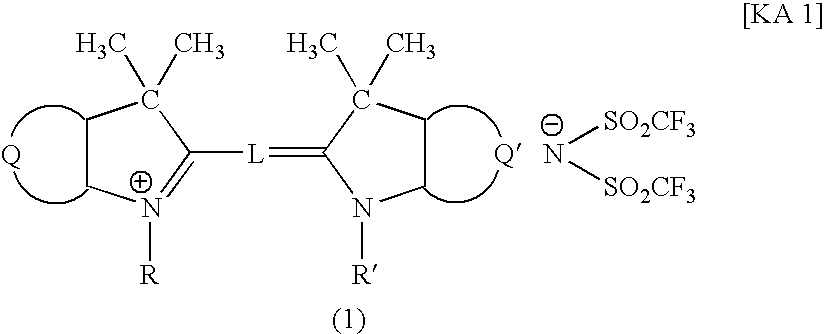Filter and Cyanine Compound
a technology of cyanine compound and filter, which is applied in the field of optical filter and cyanine compound, can solve the problems of unsatisfactory coloring matter provided, and achieve the effects of superior heat resistance, light resistance, and high molar absorbance coefficien
- Summary
- Abstract
- Description
- Claims
- Application Information
AI Technical Summary
Benefits of technology
Problems solved by technology
Method used
Image
Examples
example 1
Synthesis of Compound 1
[0056] A mixture of 9.6 parts of 1,3,3-trimethyl-2-methyleneindoline, 10.6 parts of 1,3,3-trimethyl-2-formylmethyleneindoline, 17.6 parts of potassium(bis-trifluoromethanesulfonyl)imide represented by the following formula:
in 75 parts of acetic anhydride was boiled under cooling-reflux for 1 hour, then cooled to room temperature. Subsequently, the reaction liquid was filtered under aspiration to remove insoluble impurity. Thereafter, 100 parts of water was added dropwise to the reaction liquid. The precipitated crystal was filtered under aspiration, recrystallized from 40 parts of methanol, washed with 5 parts of methanol, then with water, and dried, to obtain 19.4 parts of the aforementioned Compound 1. Spectroscopic characteristics of the resultant Compound 1 were as follows.
[0057] Maximum absorption wavelength: 544 nm (in methanol);
[0058] Molar absorbance coefficient: 133,000 (in methanol).
example 2
Synthesis of Compound 3
[0059] Into a mixed solvents of 50 parts of acetic anhydride and 25 parts of acetic acid, 14.9 parts of 4,5-benzo-1-(2-methoxyethyl)-3,3-dimethyl-2-methyleneindoline, 8.9 parts of triethyl orthoformate, 8.8 parts of potassium (bis-trifluoromethanesulfonyl)imide and 2.5 parts of concentrated hydrochloric acid were charged, and the reaction mixture was boiled under cooling-reflux for 2 hours, then cooled to room temperature. Subsequently, 25 parts of water was added, and the precipitated crystal was filtered under aspiration. The crystal was boiled in 15 parts of isopropyl alcohol under cooling-reflux for 1 hour, and then cooled to room temperature. The crystal was filtered under aspiration, washed with 5 parts of isopropyl alcohol, then with water, and dried, to obtain 13.4 parts of the aforementioned Compound 3. Spectroscopic characteristics of the resultant Compound 3 were as follows.
[0060] Maximum absorption wavelength: 588 nm (in methanol);
[0061] Molar a...
example 3
Synthesis of Compound 12
[0062] The same procedures were repeated as in Example 1 except that 14.9 parts of 4,5-benzo-1-(2-methoxyethyl)-3,3-dimethyl-2-methyleneindoline was used instead of 9.6 parts of 1,3,3-trimethyl-2-methyleneindoline, to obtain 18.3 parts of the aforementioned Compound 12. Spectroscopic characteristics of the resultant Compound 12 were as follows.
[0063] Maximum absorption wavelength: 555 nm (in methanol);
[0064] Molar absorbance coefficient: 119,000 (in methanol).
PUM
| Property | Measurement | Unit |
|---|---|---|
| thickness | aaaaa | aaaaa |
| temperature | aaaaa | aaaaa |
| temperature | aaaaa | aaaaa |
Abstract
Description
Claims
Application Information
 Login to View More
Login to View More - R&D
- Intellectual Property
- Life Sciences
- Materials
- Tech Scout
- Unparalleled Data Quality
- Higher Quality Content
- 60% Fewer Hallucinations
Browse by: Latest US Patents, China's latest patents, Technical Efficacy Thesaurus, Application Domain, Technology Topic, Popular Technical Reports.
© 2025 PatSnap. All rights reserved.Legal|Privacy policy|Modern Slavery Act Transparency Statement|Sitemap|About US| Contact US: help@patsnap.com



